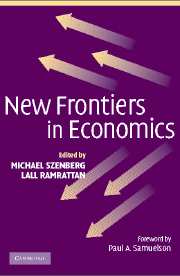Book contents
- Frontmatter
- Contents
- List of Contributors
- Foreword by Paul A. Samuelson
- Preface
- Acknowledgments
- Introduction
- PART I INFORMATIONAL BEHAVIORAL ECONOMICS AND FINANCE
- PART II MACROECONOMICS AND PUBLIC POLICIES
- 5 Whither Macro?
- 6 Recent Developments in and Future Prospects for Public Economics
- PART III INTERNATIONAL TRADE AND DEVELOPMENT
- PART IV CONTRACTS, LAW, AND GAMING
- Author Index
- Subject Index
- References
5 - Whither Macro?
Published online by Cambridge University Press: 06 July 2010
- Frontmatter
- Contents
- List of Contributors
- Foreword by Paul A. Samuelson
- Preface
- Acknowledgments
- Introduction
- PART I INFORMATIONAL BEHAVIORAL ECONOMICS AND FINANCE
- PART II MACROECONOMICS AND PUBLIC POLICIES
- 5 Whither Macro?
- 6 Recent Developments in and Future Prospects for Public Economics
- PART III INTERNATIONAL TRADE AND DEVELOPMENT
- PART IV CONTRACTS, LAW, AND GAMING
- Author Index
- Subject Index
- References
Summary
When I first began serious study of macroeconomics, twenty years ago at the London School of Economics, the field was in serious disarray. (Me being who I was, that was part of the attraction.) The Keynesian consensus of the 1960s was long gone, eroded equally by pressure from inside and from outside academia. Inside, the New Classical alternative of Robert E. Lucas and his collaborators had already replaced Milton Friedman's loyal monetarist opposition as the most significant challenger, and the Real Business Cycle initiative of Ed Prescott and others was in the air. Outside, the dismal economic performance of the 1970s had eroded confidence that economists knew how the economy worked, much less how to employ available policy tools to make it work better. Unthinkably drastic measures were being undertaken (Paul Volcker's tight money disinflation in the United States, and Margaret Thatcher's attempt to dismantle the welfare state in Britain), and no one knew how it would all turn out.
Twenty years later, the field has been put back in some order. There is, we are told, a central “core of usable macroeconomics” (Solow 1997), consisting of an updated version of the Hicksian IS-LM as a model of demand-driven business fluctuation. This central core is apparently most firmly embraced by those academics who have the most regular interactions with the practical worlds of government and business.
- Type
- Chapter
- Information
- New Frontiers in Economics , pp. 173 - 184Publisher: Cambridge University PressPrint publication year: 2004



